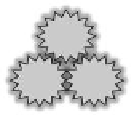Environmental Engineering Reference
In-Depth Information
(b) mineral recovery—including such processes as dissolution, iltration, calcining, roast-
ing, leaching, concentration, separation, solvent extraction, electrowinning, and precipita-
tion. The generalized procedure shown in Figure 5.6 describes the main elements of most
of the processes used.
Variations (of procedure) from the main elements can be expected between different
operating companies because of differences in mode of operation. Bulk ore transported to
the processing and extraction plant needs to be crushed to smaller fractions where speciic
chemicals and additives are added. The resultant mixture is then subjected to the required
mineral extractions processes, as required. The points of interest in regard to interactions of
the mining-milling activities and industries with the geoenvironment shown in Figure 5.7
include debris from mining, and liquid and solid waste materials from beneiciation and
processing. These discharges can be considered to be sources for various kinds of stressors.
In respect to stressors and impacts on the geoenvironment, the major sources of stress-
ors are the heaps, wastewater, and tailings ponds. The types of stressors originating from
these sources physical, chemical, physicochemical, and biogeochemical (see Figure 5.7).
Collapse and subsidence of heaps are major problems. The heaps and tailings basins are
also subjected to movement and have inlicted substantial damage in towns where the tail-
ings have liqueied and lowed into towns burying houses and people. Noxious and toxic
releases from dissolution, bacterial activity, and subsequent runoff also cause damage.
The acid water is carried into ground and surface water thereby threatening the health of
humans, animals, and the local lora.
Primary and secondary
crushers
Bulk ore
Processing�Recovery, milling,
digestion, clarification, separation,
thickening, beneficiation, etc.
Resource product
Raw material for
downstream industries
Liquid forms
Ponds
Heaps
Wastewater
Tailings, sludge, slime, slurry,
red mud, liquid wastes, etc.
Rejects, spent material,
oversize, overburden,
waste rock, etc.
FIGURE 5.6
Generalized resource extraction-recovery process. Speciic details of additives, digestion, beneiciation, etc.,
will vary according to types of resources (minerals, nonminerals, hydrocarbon) being extracted. Discharges to
the geoenvironment will take the general forms shown in the diagram.












































































Search WWH ::

Custom Search